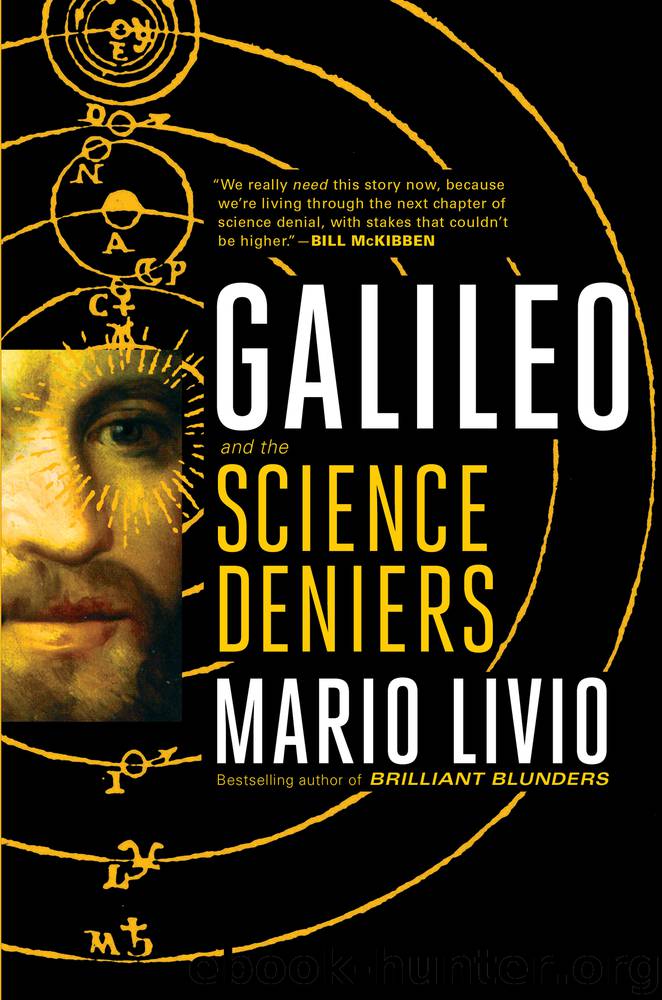Galileo by Mario Livio

Author:Mario Livio
Language: eng
Format: epub
Publisher: Simon & Schuster
Published: 2020-05-05T00:00:00+00:00
The last sentence alluded to the fact that due to the prohibition on discussing Copernicanism, Galileo didn’t feel free to speak his mind. Galileo/Guiducci added that “we should be content with that little bit that we can conjecture amidst the shadows, until we are told the true constitution of the parts of the world, because what Tycho had promised remained imperfect.” In other words, Galileo recognized that even his hypothetical scenario did not quite agree with observations, but he thought that Brahe’s theory was undermined by its own set of challenges. For instance, Brahe suggested that comets move in the opposite direction to that of the other planets. At the same time, Galileo felt formally forbidden to discuss any potential remedies to the model he had examined that could perhaps be provided by the Copernican scenario. In fact, in two works published in 1604 and 1619, Kepler suggested that comets move along straight lines, with the apparent deviation in their path being caused by the Earth’s motion. While Galileo was almost certainly inspired by Kepler’s ideas, he remained utterly silent about them.
Today we know that comets are small solar system bodies that orbit the Sun along orbits that are either very elongated (highly eccentric) ellipses or hyperbolic. They consist of nuclei that range in size from a few hundred yards to tens of miles across, and are composed primarily of ice, rock, and dust (they are “dirty snowballs”), as well as frozen carbon dioxide, methane, and ammonia. When the comets pass closer to the Sun, solar radiation vaporizes volatile material, which starts streaming out of the nucleus, forming an extended atmosphere, or coma, and two tails, one of dust and one of gas. The dust tail reflects sunlight directly, while the gas tail glows as it is being ionized. The ion tail can be as long as the distance between the Earth and the Sun. In the solar system, there are two reservoirs of comets. One is the Kuiper belt, a disk of comets just beyond Pluto that supplies most of the comets that orbit the Sun with orbital periods of less than a century. The second source, the Oort cloud surrounds the outer solar system, and its outer edge reaches almost a quarter of the way to the nearest star. The Oort cloud may contain as many as a trillion comets, and it supplies the long-period comets. Halley’s Comet, arguably the most famous comet, returns to Earth’s vicinity about every seventy-five years. It was last seen in 1986.
Galileo was correct in associating comets with the process of releasing gas, and their light with effects triggered by the proximity of the comets to the Sun, but he was wrong in even hypothesizing that the gases were released by the Earth. We should remember, though, that Galileo’s goal was not to formulate a definitive theory of comets but mainly to discredit and raise doubts about the model of Tycho Brahe, whose scenario for the solar system he had always regarded as a silly and irritating compromise.
Download
This site does not store any files on its server. We only index and link to content provided by other sites. Please contact the content providers to delete copyright contents if any and email us, we'll remove relevant links or contents immediately.
| France | Germany |
| Great Britain | Greece |
| Italy | Rome |
| Russia | Spain & Portugal |
Fanny Burney by Claire Harman(25784)
Empire of the Sikhs by Patwant Singh(22173)
Out of India by Michael Foss(16312)
Leonardo da Vinci by Walter Isaacson(11903)
Small Great Things by Jodi Picoult(6096)
The Six Wives Of Henry VIII (WOMEN IN HISTORY) by Fraser Antonia(4791)
The Wind in My Hair by Masih Alinejad(4424)
The Lonely City by Olivia Laing(4121)
The Crown by Robert Lacey(4105)
A Higher Loyalty: Truth, Lies, and Leadership by James Comey(4033)
The Iron Duke by The Iron Duke(3639)
Millionaire: The Philanderer, Gambler, and Duelist Who Invented Modern Finance by Janet Gleeson(3569)
Sticky Fingers by Joe Hagan(3454)
Alive: The Story of the Andes Survivors by Piers Paul Read(3312)
Papillon (English) by Henri Charrière(3270)
Joan of Arc by Mary Gordon(3259)
Stalin by Stephen Kotkin(3086)
Aleister Crowley: The Biography by Tobias Churton(3021)
Ants Among Elephants by Sujatha Gidla(2925)
